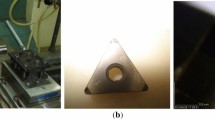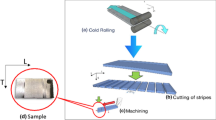Abstract
Surface integrity or in other words surface quality is a general term that is widely used in academia and industry to describe the characteristics and attributes of the workpiece surface after being modified or altered by manufacturing processes. Quality and integrity of the workpiece surface is a key design factor particularly when the part is likely to sustain severe service conditions such as very high or very low temperatures, corrosive environments, and dynamic loading and unloading. Broaching, as the focal point of this paper, is a machining operation in which roughing, semi-finishing, and finishing of the desired profile is achieved simultaneously by only one stroke of the tool with no further finishing operation required. Hence, the quality and integrity of final part during service life is directly governed by the broaching regime. The present paper aims to study the effects of broaching on the integrity of machined surface. Several samples from two types of steels (AISI 12L14, AISI 1045) and one type of aluminum (Al 7075) were prepared. The samples were examined to study both surface and subsurface characteristics of the broached surface including surface roughness, subsurface microhardness, and subsurface plastic deformation. The results showed gradual effect of successive teeth on the integrity of workpiece surface. It was shown that the surface and, to some extent, subsurface of the machined part were affected by the combined effect of successive teeth; however, it was determined that the effect of last teeth (finishing teeth) was dominant. This can be clearly seen through microhardness and surface roughness readings.
Similar content being viewed by others
References
Field M, Kahles JF (1971) Review of surface integrity of machined components. Defense Technical Information Center
Kishawy H, Dumitrescu M, Ng E-G, Elbestawi M (2005) Effect of coolant strategy on tool performance, chip morphology and surface quality during high-speed machining of A356 aluminum alloy. Int J Mach Tools Manuf 45(2):219–227
Lu C (2008) Study on prediction of surface quality in machining process. J Mater Process Technol 205(1):439–450
Davim JP (2010) Surface integrity in machining. Springer
Black JT, Kohser RA (2011) Degarmo’s materials and processes in manufacturing. Wiley
Benardos P, Vosniakos G-C (2003) Predicting surface roughness in machining: a review. Int J Mach Tools Manuf 43(8):833–844
Sata T, Li M, Takata S, Hiraoka H, Li C, Xing X, Xiao X (1985) Analysis of surface roughness generation in turning operation and its applications. CIRP Ann Manuf Technol 34(1):473–476
Sharman A, Aspinwall D, Dewes R, Clifton D, Bowen P (2001) The effects of machined workpiece surface integrity on the fatigue life of Γ-titanium aluminide. Int J Mach Tools Manuf 41(11):1681–1685
Field M (1973) Surface integrity—a new requirement for improving reliability of aerospace hardware. In: 18th Annual National SAMPE Symposium Los Angeles
Field M, Kahles JF, Koster WP (1989) Surface finish and surface integrity. ASM Handb 16:19–36
Sadat A (1990) Effect of high cutting speed on surface integrity of Aisi 4340 steel during turning. Mater Sci Technol 6(4):371–375
Öktem H, Erzurumlu T, Kurtaran H (2005) Application of response surface methodology in the optimization of cutting conditions for surface roughness. J Mater Process Technol 170(1):11–16
Zhang JZ, Chen JC, Kirby ED (2007) Surface roughness optimization in an end-milling operation using the Taguchi design method. J Mater Process Technol 184(1):233–239
Davim JP Machining of metal matrix composites, vol 2011. Springer
König W, Klinger M, Link R (1990) Machining hard materials with geometrically defined cutting edges—field of applications and limitations. CIRP Ann Manuf Technol 39(1):61–64
Jang D, Watkins T, Kozaczek K, Hubbard C, Cavin O (1996) Surface residual stresses in machined austenitic stainless steel. Wear 194(1):168–173
Lucca D, Brinksmeier E, Goch G (1998) Progress in assessing surface and subsurface integrity. CIRP Ann Manuf Technol 47(2):669–693
M’saoubi R, Outeiro J, Changeux B, Lebrun J, Morao Dias A (1999) Residual stress analysis in orthogonal machining of standard and Resulfurized Aisi 316l steels. J Mater Process Technol 96(1):225–233
Matsumoto Y, Hashimoto F, Lahoti G (1999) Surface integrity generated by precision hard turning. CIRP Ann Manuf Technol 48(1):59–62
El-Axir M (2002) A method of modeling residual stress distribution in turning for different materials. Int J Mach Tools Manuf 42(9):1055–1063
Yang X, Liu CR (2002) A new stress-based model of friction behavior in machining and its significant impact on residual stresses computed by finite element method. Int J Mech Sci 44(4):703–723
Rech J, Moisan A (2003) Surface integrity in finish hard turning of case-hardened steels. Int J Mach Tools Manuf 43(5):543–550
Jawahir I, Brinksmeier E, M'Saoubi R, Aspinwall D, Outeiro J, Meyer D, Umbrello D, Jayal A (2011) Surface integrity in material removal processes: recent advances. CIRP Ann Manuf Technol 60(2):603–626
He G, Zhang Y (1985) Experimental investigations of the surface integrity of broached titanium alloy. CIRP Ann Manuf Technol 34(1):491–494
Axinte DA, Gindy N, Fox K, Unanue I (2004) Process monitoring to assist the workpiece surface quality in machining. Int J Mach Tools Manuf 44(10):1091–1108
Axinte D, Boud F, Penny J, Gindy N, Williams D (2005) Broaching of Ti-6-4–detection of workpiece surface anomalies on dovetail slots through process monitoring. CIRP Ann Manuf Technol 54(1):87–90
Zanger F, Boev N, Schulze V (2014) Surface quality after broaching with variable cutting thickness. Procedia CIRP 13:114–119
Mabrouki T, Courbon C, Fabre D, Arrieta I, Arrazola P-J, Rech J (2017) Influence of microstructure on Chip formation when broaching Ferritic-Pearlitic steels. Procedia CIRP 58:43–48
Chamanfar A, Monajati H, Rosenbaum A, Jahazi M, Bonakdar A, Morin E (2017) Microstructure and mechanical properties of surface and subsurface layers in broached and shot-peened Inconel-718 gas turbine disc fir-trees. Mater Charact 132:53–68
Fabre D, Bonnet C, Rech J, Mabrouki T (2017) Optimization of surface roughness in broaching. CIRP J Manuf Sci Technol 18:115–127
Kishawy HA, Hosseini A, Moetakef-Imani B, Astakhov VP (2012) An energy based analysis of broaching operation: cutting forces and resultant surface integrity. CIRP Ann Manuf Technol 61(1):107–110
Hosseini, S.A., Model based simulation of broaching operation: cutting mechanics, surface integrity, and process optimization, 2013
Sajeev V, Vijayaraghavan L, Rao U (2000) An analysis of the effects of burnishing in internal broaching. Int J Mech Eng Educ 28(2):163–173
Acknowledgements
Author would like to express sincere appreciations to Prof. H. A. Kishawy (UOIT, Canada) for his invaluable support.
Funding
This project was supported by the Natural Sciences and Engineering Research Council of Canada (NSERC).
Author information
Authors and Affiliations
Corresponding author
Rights and permissions
About this article
Cite this article
Hosseini, A. On the quality and integrity of broached surfaces. Int J Adv Manuf Technol 102, 95–103 (2019). https://doi.org/10.1007/s00170-018-3132-1
Received:
Accepted:
Published:
Issue Date:
DOI: https://doi.org/10.1007/s00170-018-3132-1




